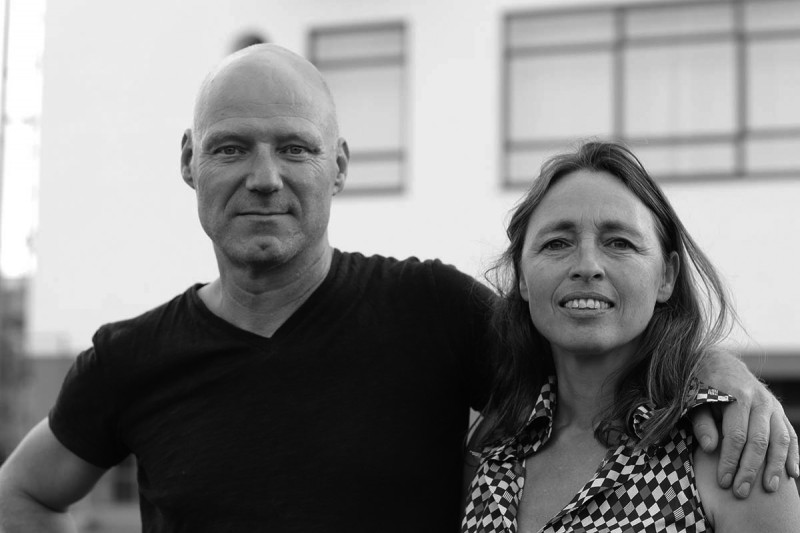

Can I touch you online? Can we measure intimacy? How does your kiss feel in EEG Data?
Artists and researchers duo Karen Lancel and Hermen Maat (Lancel/Maat) work interdisciplinary in art, science, technology and society. They are considered pioneers exploring shared experience of embodiment, empathy and intimacy, identity, privacy and trust, in bio-technical entanglement with (non-)human others, in sustainable ecologies.
Lancel/Maat's works have been presented and awarded internationally, and include visual art, media art, (large-scale) participatory performances and spatial installations; theater and internet art.
TheirArtistic and Scientific Research, into social and bodily connections in complex participatory systems and mixed realities, has led to Dr. Lancel's PhD thesis (2023) (download) at the University of Technology Delft, focussing on the question "Can I Touch you Online?".
AWARDS. Lancel/Maat's work received an EMAP European Media Art Platform Award (Europe Cultural Program) 2018-2021; the NFF Golden Calf 2019 Netherlands Film Festival nomination 'Interactive'; the International TASIE 2019 / Wu Guanzhong Prize for Art, Science, Innovation in China; and the GAAC Global Art & AI Competition Award China. It is included in the Dutch Digital Art Canon for Media Art 1960-2000, by Li-MA Media Art Platform Amsterdam.
WORKS. The artworks exists of an aesthetic Meeting spaces and (‘Artistic Social Labs’) and inclusive dialogue platforms ('Reflexive Data-Scapes'). The audience is invited as co-researchers to explore performance scripts for poetic Trust-Systems and Trust Rituals. For these scripts the artists radically re-assemble communication and control systems (brain, robot, social touch and face technologies) and re-wire shared neural sensations of seeing, hearing, touching and feeling touched, in AI generated synthesized connections. The audience is carefully hosted to embarq on an immersive sentient journey, to explore new shared sensitivity with fluid boundaries between self, others and data.
The works are designed to provoke shared storytelling, awareness and imagination. Lancel and Maat consider their works to be a form of activism, that facilitates agency to co-create new narratives for a sense of interdependency and “togetherness” key to social change in future post-anthropoceen co-existence.
PARTNERSHIPS. Lancel/Maat’s multi-disciplinary Art and Science partnerships have inspired new perspectives on ethics and design of emotional well-being: social connection, disconnection, isolation (f.e. through (collective) trauma); neurodiversity, (tele-)presence.
Literature Lancel/Maat's media performance works and aesthetics of interaction resonate with the philosophical Phenomenological tradition (M. Merleau-Ponty); Feminist Studies; Computer science (AI in Complex systems) and Actor Network Theory. Their innovative designs of 'Digital interpersonal touch' make use of Neuroscience research into Synaesthetic Perception (a.o. Mirror-Touch) and Empathetic Reciprocity.
PRESENTATIONS, RESEARCH, PUBLICATIONS, WORKS IN COLLECTIONS
Lancel and Maat give presentations internationally as exhibitors, (keynote) speakers, lectures, workshops, educators, researchers .
Presentations in Europe, Asia and USA (find here) include: Venice Biennial 2015; Ars Electronica Festival Linz; ZKM Karlsruhe; Stedelijk Museum Amsterdam; National Museum of China; ISEA Gwangzou South Korea; Nabi Art center Seoul; LABoral Gijón; Eyebeam New York; Sonic Acts Amsterdam; Transmediale Berlin.
Generous support and Grants (find here) were received from a.o. Mondriaan Fund; Fund for Creative Industries; NWO Dutch Scientific Research Organisation, European Cultural Program; and is represented by Public Art Lab Berlin (find here). Their works are part of public Collections of a.o. ZKM Karlsruhe; Digital-Canon LIMA; KPN Telecommunication Netherlands.
Artist-in-residencies and Fellowships were generously facilitated by EMAP European Media Art Platform; TASML Tsinghua University Beijing, Banff Media Center Canada; Iaspis Stokholm; EIT Europe; University of Applied Science Vienna; TU Delft; and Public Commissions by a.o. UP Projects London, Kunstgebouw Zuid-Holland and Rijksmuseum Amsterdam (find here).
Teaching appointments include BA/MA Hanze University Groningen, where Dr. Lancel headed the MA Media Art department between 2005-2009; Tsinghua University Beijing, MA HKU Utrecht; MA Art-Science KABK The Hague; MA Artez Enschede and Arnhem (find here).
Publications (find here) including Lancel/Maat's work have been published by among others Routledge, MIT Press, De Gruyter Publishers, Neural, Metropolis M, CHI, Intellect Books UK, Springer Verlag. Papers authored by Lancel/Maat (find here) have been published by Springer Verlag, InderScience, TEDx, CHI, ArtsIT, Leonardo, International Journal of Performance Arts and Digital Media - Francis & Taylor Publishers, MIT Press.
In Science, data represent things - in Art data point at themselves for shared imagination.